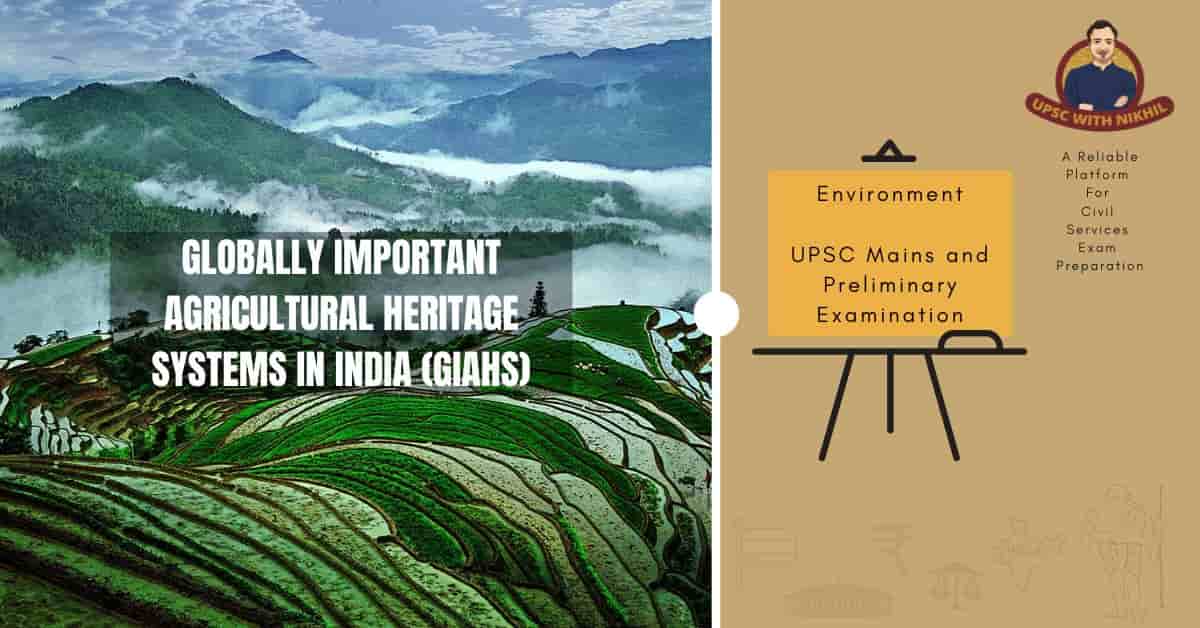Globally Important Agricultural Heritage Systems In India (giahs)
GIAHS are exceptional landscapes of exceptional aesthetic beauty that combine agricultural diversification, robust ecosystems, and priceless cultural legacy. They sustainably supply a variety of commodities and services, as well as food and livelihood security for millions of small-scale farmers in specific locations around the world. Unfortunately, a number of issues, such as climate change and rising competition for natural resources, are threatening traditional agricultural systems. They must also deal with migration brought on by poor economic viability, which has led to the abolition of traditional farming methods and the extinction of endemic species and breeds.
The agricultural advancements and technology of today and the future are built on the foundation of these ancient agricultural systems. In many places of the world, their distinct agricultural systems have preserved their cultural diversity as well as their ecological and agricultural diversity.
Till date, it has awarded the designation to 67 sites in 22 countries, with 13 additional proposal pending.
In India, Giahs Includes;
Koraput Traditional Agriculture:
The Koraput Region's traditional communities and traditional systems are closely related. According to their beliefs and methods, a significant amount of biodiversity has been preserved through in-situ conservation, which protects indigenous species. Even though the local communities provide essential ecological services, they are among the poorest in the nation and the globe. Not always enough food is produced to meet everyone's needs throughout the year.
The 2500 kinds of flowering plants that make up the vast floristic diversity of the local communities are preserved thanks to their traditional agricultural practices, which are environmentally friendly and incorporated into their surroundings. Sacred groves are an efficient way to conserve plant genetic resources since they are closely tied as a cultural characteristic. A forest patch is protected through a social process that also preserves its biological heritage and has religious importance.
The acknowledgment of this GIAHS would aim to enable rural communities to profit financially from their historical and ongoing contributions to the conservation of genetic resources in light of the threats to forest and agro biodiversity, such as mining and deforestation. This would be a component of the social integration and value-adding of the neighborhood communities.
Note-It was designated as GIAHS in 2012.
India's Kuttanad below Sea Level Farming System:
Since it is the only system in India that encourages rice growing below sea level in the land produced by draining delta wetlands in brackish waters, the Kuttanad Wetland Agriculture System is exceptional. It intends to address concerns with soil availability and floods in agriculture as a way to deal with the impending effects of climate change in coastal areas and develop effective strategies.
The Kuttanad system is an intricate mosaic of dispersed agricultural landscapes organized into three structures: wetlands used for paddy operations and fish capturing, garden lands used for coconut, tubers, and food crop plantation, and water areas utilized for inland fishing and shellfish. Thanks to the construction of polders with bunds and its dewatering, wetland areas are produced. The protection of this fragile and unique system from any external pressure is important and urgent for humanity because it is essential for maintaining and enhancing so much endemic biodiversity and several crucial ecosystem services for human well-being worldwide. Waters are facing severe pollution due to tourism but also from the use of chemicals.
Note-In 2013, it received the GIAHS designation.
Kashmir Valley, Pampore area:
Kashmir in India is also known as a Saffron Heritage Site. The best region for cultivating different crops, such as grains like maize, rice, rajmah/lentils, fruit and vegetable crops, and pulses. A number of distinctive low-tillage conventional farming techniques are widely used. The region is also best suited for agra-forestry, which is a common practice during the fallow season for growing mulberry, fruit, and fodder trees along farm boundaries. Agricultural management techniques are used in the region to increase productivity. Young people's initiatives to value and preserve heritage
Recently in 2022, Food and Agricultural Organization has designated 4 tea cultivation sites as the Globally Important Agriculture Heritage system (GIAHS);-
1. Traditional Tea-grass integrated system (Japan).
2. Traditional Hadong Tea Agrosystem,Hwagae-myeon (Republic of Korea).
3. Pu’er Traditional Tea Agro system (China).
4. Fuzhou Jasmine and Tea culture system (China).



